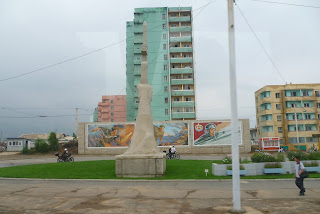Everyday life in North Korea
Similar to the caste system in India, the Songbun status system plays a major role in deciding how North Koreans live their lives even before one is born. Based on a person’s bloodline, the system determines one’s access to education, food, jobs and more. The system was into place in the late 50s determined that those who were landowners in the 1950s and those who committed political crimes are lowest in the order and while those who committed their efforts to the Japanese resistance during the war rank the highest. But this “system” isn’t obvious to people and one has no idea the system exists…until someone who is capable is continuously barred from opportunities.
Our tour guide told us that all North Koreas get free education and housing. Males get a housing unit when they get married and are given incentives such as bigger apartments to raise bigger families. It is mandatory for males to train in the army, and whether someone has trained as an army officer is a common trait that women look for when seeking for potential husbands. Our tour guide joked about marrying a foreigner since she hasn’t found a husband, but leaving North Korea is no easy task. Some North Koreans work as foreign workers in Russia and China so their country can earn money on foreign currency. North Koreans earn about 200 to 500 RMB a month, depending on what they do. Teachers, soldiers and doctors are on higher wages while those in the service industry earn the least. Farmers might be those working the hardest but everything that is grown belongs to the government.
Foreigners aren’t allowed to use North Korean currency, so the exchange rate has been a mystery. But it doesn’t really matter because North Koreans only need very little money when using ration coupons. The foreign currency spent by tourists is mainly how the government earns the big bucks. While there might be a slight difference in wages depending on a person’s profession, everyone is required to help out on a farm each year, especially students on their summer holidays. The volunteering also extends to maintaining the city’s beautiful image. When I first passed by the city’s green pastures from afar, I saw what looked like sheep hanging out on the pastures, but they were actually students voluntarily weeding and they were all wearing their white uniforms! University graduates get to have three choices when deciding on their jobs. Whether they get their desired profession depends on their background, looks and grades. The more presentable people get picked to work as performers, tour guides and even traffic guards since they are most seen by tourists. Those working as foreign workers earn around the same wage, but they are not allowed to leave their work premises but are allocated the opportunity to shop.
Foreigners aren’t allowed to use North Korean currency, so the exchange rate has been a mystery. But it doesn’t really matter because North Koreans only need very little money when using ration coupons. The foreign currency spent by tourists is mainly how the government earns the big bucks. While there might be a slight difference in wages depending on a person’s profession, everyone is required to help out on a farm each year, especially students on their summer holidays. The volunteering also extends to maintaining the city’s beautiful image. When I first passed by the city’s green pastures from afar, I saw what looked like sheep hanging out on the pastures, but they were actually students voluntarily weeding and they were all wearing their white uniforms! University graduates get to have three choices when deciding on their jobs. Whether they get their desired profession depends on their background, looks and grades. The more presentable people get picked to work as performers, tour guides and even traffic guards since they are most seen by tourists. Those working as foreign workers earn around the same wage, but they are not allowed to leave their work premises but are allocated the opportunity to shop.
If you look at what people wear on the streets of Pyongyang, high heels are an essential item for women. If you go down into the subway stations, the sound of high heels is even more evident (the subway system is pretty cool and resembles the one in Russia with the deeply dug stations that act as bomb shelters and elaborate paintings and grandiose chandeliers). Like everything else on sale in North Korea, the locally made items are the most affordable, especially with the ration coupons given to each person, but for the better quality items, the majority of which are imported from China, nothing comes cheap.
























































